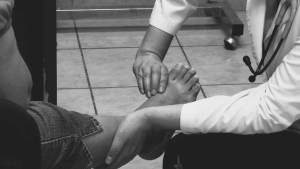If you’re dealing with lingering pain from a previous ankle injury, trust us when we say you’re not alone. Lots of people experience ongoing discomfort for weeks or even months after their initial sprain.
Ankle sprains are among the most common injuries we see at the London Foot and Ankle Centre and, unfortunately, many patients come to us months after their initial injury wondering why they’re still experiencing problems.
The truth is that most acute ankle sprains heal within a few weeks, so if you’re still in pain, then you are probably going to need more comprehensive treatment to achieve complete recovery. Whether your sprain occurred recently or years ago, there are effective strategies to help you recover and return to your normal activities with confidence.
Understanding Your Symptoms
When an ankle sprain doesn’t heal properly several issues can develop. You might start to notice ongoing stiffness, weakness, or a feeling that your ankle might “give way” during more rigorous activities. These symptoms occur because the ligaments that support your ankle joint haven’t fully healed or may have healed in a stretched position, compromising your joint’s stability.
Swelling that persists beyond the initial injury period is another common concern. This ongoing inflammation can limit your range of motion and contribute to continued discomfort.
Additionally, the muscles around your ankle could have weakened during the period when you were protecting the injured area, reducing support for the joint.
Effective Treatment Strategies
Understanding how to treat an old ankle sprain begins with a thorough assessment of your current condition.
- Start by gently testing your ankle’s range of motion.
- Move your foot up and down, side to side and in circular motions.
- Note any areas where movement feels restricted or painful.
Ankle strengthening exercises form the foundation of recovery for chronic ankle issues. Begin with simple exercises using a resistance band or towel.
Balance training is equally important for restoring stability. Stand on one foot for 30 seconds, gradually increasing the duration as your stability improves. Progress to standing on unstable surfaces like a pillow or balance board to really challenge your ankle.
Physical therapy techniques can significantly accelerate your recovery. Ice application after activity helps control inflammation, while gentle heat before exercise can improve flexibility.
Contrast baths, alternating between cold and warm water, may promote circulation and reduce stiffness.
Managing Pain and Inflammation
Over-the-counter anti-inflammatory medications help reduce swelling and discomfort. However, these should be used correctly and according to package directions. Topical anti-inflammatory gels will provide localised relief but won’t help fixing the underlying problem.
Proper footwear plays a crucial role in your recovery. Choose shoes with a firm sole and stable heel counter. Avoid high heels or shoes with minimal support during your recovery period. Consider using an ankle brace during activities if your ankle feels unstable, but don’t rely on it permanently as this can lead to muscle weakness.
Prevention of Future Injuries
Once you’ve addressed your current ankle issues, focus on preventing future problems. Maintain the strength and flexibility gains you’ve achieved through regular exercise. Continue balance training exercises as part of your routine fitness program.
Pay attention to your walking surfaces and avoid uneven surfaces where possible. When participating in sports, wear the appropriate footwear and consider using supportive tape or a brace if you need the extra help.
Recovering from an ankle injury successfully requires patience, consistency and the right approach. Most chronic ankle problems can be resolved, but you’ve got to be ready to handle them with proper care and attention.
Don’t let an old ankle sprain continue to limit your daily activities and quality of life. Book with one of our experienced specialists for a personalised treatment plan to get you back on your feet and start your journey to complete recovery and lasting stability.


Matthew Solan
This article was reviewed by Mr Matthew Solan, a consultant orthopaedic surgeon. He has been with LFAC since its formation in 2003.


